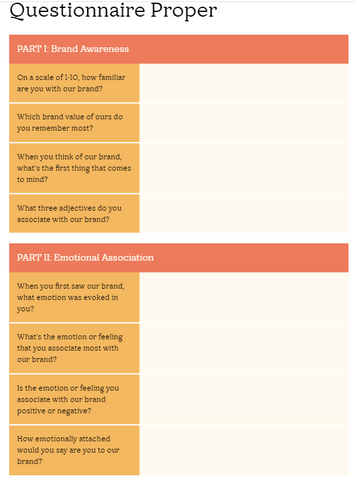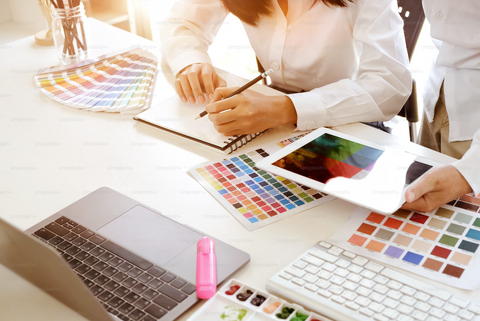How to Create a Brand Identity?

In the crowded marketplace of today, having a strong brand identity has become indispensable for businesses. A brand extends beyond mere logos and taglines – it encompasses experiences, expectations, and relationships.
Brand identity, then, is the visual and verbal expression of a brand. By differentiating itself from competitors, a company can attract attention and make its products or services more recognizable to potential customers. It helps to shape the perception of a company in the minds of customers, partners, and competitors.
What is brand identity?
Brand identity is the collection of all elements that a company creates to portray its image to the consumer. It's not just about how a brand looks; it's also about how it feels and speaks.
The identity should be a consistent message that resonates with your audience and can evolve with the brand over time. It is essentially how a business wants to be perceived by consumers and includes every aspect that represents the business.
Why do businesses need a brand identity?
A solid brand identity can build customer loyalty and trust in a product, which becomes a significant competitive advantage. It gives a clear direction for brand strategy and marketing initiatives, helping differentiate a business from its competitors.
Moreover, a well-crafted brand identity conveys the company’s purpose and promises to customers, facilitating a deeper emotional connection with them.
What elements does brand identity have?
Creating a brand identity involves mainly several components:
- Logo: A recognizable graphic design element, often including a name, symbol, or trademark, representing an organization.
- Color Palette: A specific set of colors consistently used across all visual elements, which can provoke different emotions and convey specific brand personality traits.
- Typography: The font styles chosen to communicate the brand's message play a crucial role in maintaining a cohesive identity.
- Imagery: This includes the use of photos, illustrations, and any other visual content that supports the brand's message and values.
How to build brand identity?
Understand Brand's Core Values and Mission
Knowing what your brand stands for and why it exists is the starting point for creating a brand identity that truly represents your business.
It involves both introspection and research, requiring you to dive deep into the ethos of your business—what it represents, its culture, developing history, and its aspirations.
Know Your Audience
Understand who you're talking to. Research your target market to ensure your brand identity resonates with them on a personal level.
Use surveys, focus groups, interviews, and questionnaires to gather information directly from members of your target audience. Engaging directly with your audience is key to developing a more profound comprehension of their needs and preferences, which can consequently enhance your brand's reputation and foster greater customer loyalty.

Analyze Your Competition
See what others in your niche are doing right and wrong. This can help you find ways to differentiate your brand.
Use various sources such as market reports, online search engines, industry publications, and customer feedback to analyze their strategies. Take note of what competitors are doing well that you can incorporate into your own strategy. Ensuring not to replicate them entirely but rather to refine and enhance your unique offerings. Additionally, it's crucial to learn from their misstep to avoid similar pitfalls.
Define Your Brand Personality And Voice
Decide what characteristics and attributes you want to be associated with your business to guide how your brand communicates with the world. Determine the brand tone, language, and rhythm of your communication. Is it formal or casual? Authoritative or conversational? Enthusiastic or calm?
Your brand personality and voice should be genuine to your brand’s identity. When done correctly, they help build trust and foster a stronger emotional connection with your audience.
Establish Brand Strategy Objectives
Establishing brand strategy objectives is a vital step to ensure that your branding efforts are purposeful and aligned with your overall business goals. Perform an in-depth analysis of your current brand positioning and performance. Then, evaluate your brand’s strengths, weaknesses, opportunities, and threats, which is called SWOT analysis.

Remember that strategy objectives should be revisited and updated periodically to reflect changes in the market environment, consumer behavior, and the competitive landscape.
Create a Visual Identity
Apply your visual branding, such as logo, colors, and typography uniformly across all materials, including digital content, packaging, signage, and merchandise. Use templates where possible to maintain design consistency.
When creating a visual identity, it's essential to remain focused on the brand's core message and creating a versatile and lasting visual language. Here's a step-by-step guide for digital content :
- Understand the Digital Context
- Optimize Logo Design
- Responsive Color Palette
- Typography for Digital Readability
- Adaptive Imagery Style
- Interactive Elements Like Animations or Icons
- Digital Templates and Layouts

Legally Protect Brand Identity
Trademark protection is essential to prevent competitors from using similar identifiers that could confuse customers. By registering a trademark for their logos, slogans, and product names, businesses can legally protect these elements from unauthorized use.
When infringement occurs, businesses can utilize legal tools to safeguard their brand identity, ensuring that the value they've built in their brand is protected from exploitation by others.
Develop Your Brand Story
A compelling story can captivate an audience, evoke emotions, and create a memorable experience that resonates deeply with customers.
Tell a story that embodies your values and mission, engages your audience, and gives your brand a human touch. Align all content like blogs, videos, and podcasts with your brand story and values.
Implement Across All Touch-points
The implementation phase involves applying all the elements of the brand strategy consistently across every customer interaction point both online or offline, from marketing to customer service.
Craft core messages that align with your brand story and values. Consistently infuse this messaging throughout all promotional content, advertisements, public statements, and internal communications to ensure a unified approach to establishing your brand's identity.
Additionally, businesses can select branded gifts featuring their distinct imagery to offer customers, such as bags emblazoned with the company logo, T-shirts, or stickers adorned with mascot designs that are synonymous with the brand. For packaging and labeling needs, consider using white thermal labels with your company's logo or message. Such items not only enhance customer loyalty and satisfaction but also amplify the brand's presence, carrying its message to wider audiences and communities.

SEE ALSO: 5 Ways to Use Sticker Labels For Your Business
Monitor and Adjust
Understanding your brand's core values and mission is not a one-time task—it should be an ongoing process.
As your business evolves, periodically revisit and refine your values and mission to ensure they remain relevant and authentic to your brand.
Examples of Successful Brand Identity
A successful brand identity is the visible elements of a brand, such as color, design, and logo, that identify and distinguish the brand in consumers' minds. It's a crucial part of a company's brand. Here are three examples of companies that have created strong, iconic brand identities:
Apple
Apple's brand identity revolves around sleek, minimalistic design and innovation. Its bitten apple logo is one of the most recognized symbols worldwide. Their consistent use of white space, simple lines, and a focus on product functionality and aesthetics contribute to a brand associated with quality and cutting-edge technology.

Nike
Nike's swoosh symbol and "Just Do It" slogan comprise one of the most well-known brand identities in the world. The simplicity of the logo, combined with the empowering message of the slogan, appeals to athletes and non-athletes alike. Nike's branding consistently emphasizes performance, motivation, and determination.

McDonald's
The Golden Arches are globally recognized and represent more than just fast food; they stand for an experience and are a symbol of Americana. McDonald's uses consistent colors (red and yellow), characters (like Ronald McDonald), and imagery in their branding to communicate quick service, fun, and family-friendly atmosphere.

Wrap Up
To create a distinctive and memorable brand identity, small businesses should start by understanding their core values and mission, knowing the target audience, and continuously monitoring the brand's performance in the market.
By crafting a strong brand identity, businesses can establish a unique position in the marketplace, attract and retain loyal customers, and build the foundation for long-term success. Investing time and resources into developing a brand identity is not just important—it’s essential for differentiating your offering in a world where consumers have endless choices. Take immediate action to customize your brand identity to establish a more compelling and competitive market presence!

